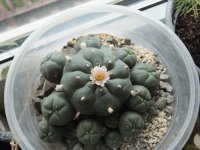Ulim
Rising Star
One can clearly see the movements of the flower
I saw a vid of it happening and wanted to try it too.
The movement is rather quick and resets after roughly 10 minutes.
I believe this is to improve pollen distribution to insects because they dive in for nectar and trigger the stamen to close around it making sure it catches a lot of pollen when it the insects squeeze out. Its optimized so every size of insects gets dusted as the desert prolly only gives sparse insect population.
[YOUTUBE]
See attached avi for my version or join into chat for a high quality version as i cannot attach that here.
Its clearly visible around :30 and also if you compare the start to the end. The camera does not move so its clearly visible how the flower changed :thumb_up:
I saw a vid of it happening and wanted to try it too.
The movement is rather quick and resets after roughly 10 minutes.
I believe this is to improve pollen distribution to insects because they dive in for nectar and trigger the stamen to close around it making sure it catches a lot of pollen when it the insects squeeze out. Its optimized so every size of insects gets dusted as the desert prolly only gives sparse insect population.
[YOUTUBE]
See attached avi for my version or join into chat for a high quality version as i cannot attach that here.
Its clearly visible around :30 and also if you compare the start to the end. The camera does not move so its clearly visible how the flower changed :thumb_up:


